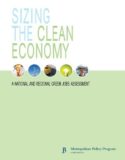Clean energy jobs are growing much faster than the rest of the economy; state policies are at the center of that growth
 Last week, our friends at the Brookings Institution Metropolitan Policy Program released an important report assessing the size and growth of the clean economy, “Sizing the Clean Economy: A National and Regional Green Jobs Assessment.” The research in this report provides an excellent start toward gathering the data on jobs, growth trends and geography needed to develop effective clean energy economic development policies.
Last week, our friends at the Brookings Institution Metropolitan Policy Program released an important report assessing the size and growth of the clean economy, “Sizing the Clean Economy: A National and Regional Green Jobs Assessment.” The research in this report provides an excellent start toward gathering the data on jobs, growth trends and geography needed to develop effective clean energy economic development policies.
While the authors’ definition of the “clean economy” goes far beyond renewable energy, the report does a great service to provide, for the first time, a detailed breakdown of specific clean energy sectors and growth trends.
The Brookings team found that today the total “clean economy” in the U.S.- defined as all industries that produce goods and services with an environmental benefit- makes up 2.7 million jobs. The renewable energy sector makes up only 5% of those jobs- but they followed similar and in many cases more impressive trends than the total clean economy. They are fast-growing, manufacturing- and export-intensive, and offer better-than-average pay to workers with modest education.
A key conclusion of the report is that these new energy sectors have had the highest growth rates over the past decade- higher than the rest of the clean economy and far greater than the economy as a whole – albeit from relatively low bases.
According to the report, from 2003 to 2010
“four of the five fastest-growing segments [of the clean economy] were in renewable energy. Solar thermal grew at a torrid pace, expanding by 18.4 percent annually over the seven years and adding 3,700 jobs. The wind power industry added 15,000 jobs, growing 14.9 percent per year. Solar PV added 12,286 jobs with 10.7 percent average annual growth. Moreover, biofuels, another renewable segment, added 9,300 jobs with 8.9 percent growth each year over the period.
Young, technology-heavy segments were also adding jobs at elevated rates each year over the period. For example, establishments involved in fuel cell production created roughly 3,500 jobs while those working in smart grid added 7,000, with annual growth of 10.3 and 8.6 percent respectively.
The takeaway: emerging, new companies in the clean economy had a substantially greater job creation impacts than their “non-clean” peers in the national economy.”
The clean energy sector is also more export intensive- seven of the top eight sectors were energy technologies: biofuels/biomass, electric vehicle technology, battery technology, wind, solar PV, and fuel cells. The most export-intensive “category” of sectors was renewable energy technologies, at $64,884 in exports per job, compared to only $20,129 for the aggregate clean economy.
The report also begins to look at why certain regions have seen such high growth- what policies are most important?
A key take away here (no surprise to us) is that state policy has been leading the way. And in the energy sector in particular, a number of state clean energy fund programs are highlighted as case studies.
- The New York state Energy Research and Development Agency’s (NYSERDA) energy and environmental technology energy incubator, iCLEAN, is noted for its success at driving the clean tech industry in the state.
- The California Energy Commission’s Alternative and Renewable Fuel and Vehicle Technology Program, is also highlighted as a model for its loan guarantees and other financial instruments.
- Boston, home to the Massachusetts Clean Energy Center, also ranked seventh among the 100 largest metro areas for employment in the alternative energy industry, with nearly 4,300 alternative energy jobs.
The report offers three overarching policy recommendations:
- Foster demand for a vibrant domestic market
- Ensure the availability of adequate finance
- Promote innovation
These recommendations are a great start to thinking about clean energy in a new way – as an economic development opportunity. The key is to develop new and dedicated economic development programs, which go beyond funding individual projects.
Here at Clean Energy Group and the Clean Energy States Alliance, we are starting to work with states to share experiences with their new economic development programs in the clean energy space.
But that’s only a beginning. A new, national effort to bring together all the economic development and clean energy practitioners to work toward better and smarter policies is the next important step.


